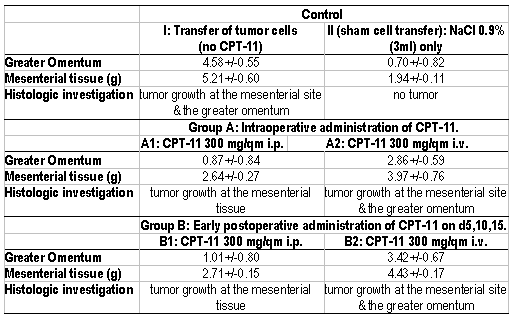# 108190 Abstract ID: 108190 Beneficial Intraperitoneal (I.P.) versus Intravenous (I.V.) Application of CPT-11 to Reduce Tumor Spread in Experimentally Induced Peritoneal Carcinomatosis
Arndt Hribaschek, Frank Meyer, Walter Halangk, Hans Lippert, Karsten Ridwelski, Magdeburg, Germany; Dessau, Germany
Recurrent tumor growth at the peritoneal tumor site after surgical resection of colorectal carcinoma remains an unsolved problem. Currently, there is no established or standardized protocol for prevention or treatment of peritoneal carcinomatosis. The aim of the study was to investigate whether CPT-11 can alter i.p. tumor spread using different modes of drug application. Methods: I.p. tumor growth was induced using tumor cells (100,000) derived from a colon carcinoma cell line, which were transfered into the abdominal cavity of WAG-rats (weight, 250-260g). Animals were devided in 3 groups: 1) CPT-11 was applied directly into the abdominal cavity (i.p., A1) or i.v. (A2) following i.p. tumor cell transfer; 2) Early postoperative i.p. (B1) & i.v. (B2) chemotherapy was administered on day(d)5,10&15 after surgical intervention. Thirty days after tumor cell transfer, rats were sacrificed & tumor weight was determined at the greater omentum & mesenterial tissue. Specifics of tumor growth were assessed using histological investigation. Results: Table 1. Tumor weight & histologic detection of tumor cells at 2 relevant sites as parameter for experimentally induced tumor growth altered by i.p. or i.v. CPT-11 administration at different time points (look below). Summary: CPT-11 generates a significantly inhibitory effect on peritoneal tumor growth. Direct i.p. application of CPT-11 induced a more pronounced effect on inhibiting peritoneal carcinomatosis as compared with i.v. application of the drug. In conclusion, combination of cytostatic agents & new drugs generating different effector mechanisms may help to further diminish or even to prevent i.p. tumor growth.

|
 500 Cummings Center
500 Cummings Center +1 978-927-8330
+1 978-927-8330
 +1 978-524-0461
+1 978-524-0461